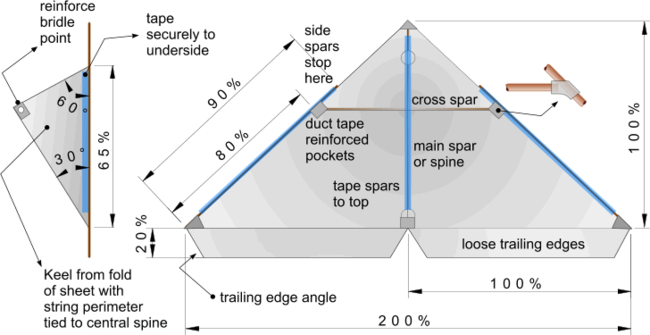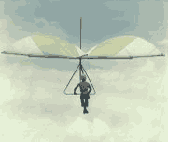Delta Kite Construction: Difference between revisions
From DT Online
m (Added Category) |
(Added Kite Designer) |
||
| Line 1: | Line 1: | ||
[ | [[File:DeltaKite.png|650px|right]] | ||
__TOC__ | |||
[[ | =====Description===== | ||
[https://en.wikipedia.org/wiki/Rogallo_wing '''Delta Kites'''], like [https://en.wikipedia.org/wiki/History_of_hang_gliding '''Hang Gliders'''], are based on [https://en.wikipedia.org/wiki/Francis_Rogallo '''Rogallo's'''] flexible wing. They are suitable for moderate breezes. | |||
Some general proportions and a basic method of construction is shown opposite. | |||
{{Packaging Designer Guide}} | |||
---- | |||
<span style="color: green">'''Note:'''</span> | |||
* <span style="color: green">The main variable in the table below is the total length of the '''Kite Spine''' ''(set initally to 1200mm)</span> | |||
* <span style="color: green">All other dimensions are derived as a '''Percentage of the Spine Length''' ''(e.g the total '''Width''' is set initally as twice the '''Spine Length''' - or 200%)''. </span> | |||
* <span style="color: green">All '''Percentages''' initially are based on the proportions given at the start of this article but all can be changed by clicking in the table and typing in a new '''Percentage''' ''(e.g. to make a more pointed '''Delta''' by reducing the '''Width''')''</span> | |||
---- | |||
<dtapollonius dwg="/images/3/38/KIite_delta.txt"></dtapollonius> | |||
=====Delta Kite Examples===== | |||
* Hang gliders are based on the flexible kite wing designed in 1948 by Francis Rogallo, a NASA aeronautical engineer and in 1958 further developed by him into the 'parawing', a structure-less kite used to enable spacecraft to land. | * Hang gliders are based on the flexible kite wing designed in 1948 by Francis Rogallo, a NASA aeronautical engineer and in 1958 further developed by him into the 'parawing', a structure-less kite used to enable spacecraft to land. | ||
Revision as of 17:13, 23 November 2016
Description
Delta Kites, like Hang Gliders, are based on Rogallo's flexible wing. They are suitable for moderate breezes.
Some general proportions and a basic method of construction is shown opposite.
Designer
- Click on the pencil-shaped Edit icon below to show or hide variables and click inside table to alter values (scroll to see all).
- Left or Right click on the screen display or use Scroll Wheel to alter view and Left click on Zoom icon to restore (note: Zoom will be focussed around the cursor position)
- Left click on Download icon and Open with your preferred browser then print screen image from there (useful for trying ideas for text and graphics etc. but unlikely to be actual size), or Save File to create a full-size Scalable Vector Graphics (svg) file which can be loaded into LibreOffice Draw and printed, or graphics software such as Inkscape for eventual output at actual size to a Plotter/Cutter for example. See Packaging Designer User Guide for more detail.
Note:
- The main variable in the table below is the total length of the Kite Spine (set initally to 1200mm)
- All other dimensions are derived as a Percentage of the Spine Length (e.g the total Width is set initally as twice the Spine Length - or 200%).
- All Percentages initially are based on the proportions given at the start of this article but all can be changed by clicking in the table and typing in a new Percentage (e.g. to make a more pointed Delta by reducing the Width)
Delta Kite Examples
- Hang gliders are based on the flexible kite wing designed in 1948 by Francis Rogallo, a NASA aeronautical engineer and in 1958 further developed by him into the 'parawing', a structure-less kite used to enable spacecraft to land.

















